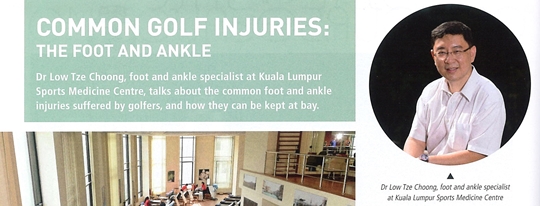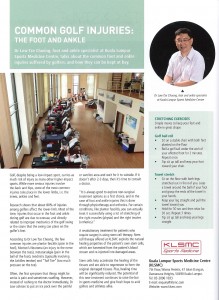
[Circular] Common Golf Injuries: The Foot and Ankle

Dr Low Tze Choong, foot and ankle specialist at Kuala Lumpur Sports Medicine Centre, talks about the common foot and ankle injuries suffered by golfers, and how they can be kept at bay.
Golf, despite being a low-impact sport, carries as much risk of injury as many other higher-impact sports. While more serious injuries involve the back and hips, some of the most common injuries take place in the lower limbs, i.e. the knees, ankles and feet.
Research shows that about 80% of injuries among golfers affect the lower-limb. Most of the time, injuries that occur in the foot and ankle during golf are due to overuse, and directly related to improper mechanics of the golf swing or the strain that the swing can place on the golfer’s feet.
In a proper golf swing, the golfer’s weight should be evenly distributed on both feet, especially during the set-up and downswing phases.
Dr Low Tze Choong, foot and ankle specialist at the Kuala Lumpur Sports Medicine Centre (KLSMC), sees his fair share of golfers on a regular basis. In his experience, there are a few common foot and ankle injuries among golfers: plantar fasciitis (pain in the heel), Morton’s Neuroma (an injury to the nerve between the toes), metatarsalgia (pain in the ball of the foot), and tendinitis (typically involving the Achilles tendon).
Another common injury of the big toe is “Turf Toe” – where the heel is raised and too much pressure is put on the toe.
“At the end of the swing, the big toe is put under a lot of strain and goes into hyper-extension – where the toe is forced up. In that position it puts a lot of strain on the joint, and the toe undergoes a lot of wear and tear,” said Dr Low. Turf Toe can also occur when golfers squat down to assess the green before or after they take a shot.
Often, the first symptom that things might be amiss is pain and sometimes swelling. However, instead of rushing to the doctor immediately, Dr Low advises to put an ice pack over the painful or swollen area and wait for it to subside.
Generally, the swelling should subside within 2-3 days if the injury is not major. On the other hand, if the swelling persists and your movement is disrupted, then it might be time to consult a doctor.
“It is always good to explore non-surgical treatment options as a first choice, and in the case of foot and ankle injuries this is done through physiotherapy and orthotics. For certain conditions, like plantar fasciitis, you can actually treat it successfully using a lot of stretching of the right muscles (physio) and the right insoles (orthotics).
“Assessing the patient’s current footwear can help determine the right type of insoles that the patient needs for his or her condition. The right insoles can help to adjust the foot accordingly. When selecting footwear, more rigid footwear is generally better in terms of the support that it provides to your feet and ankle. Of course, failing all these, if the patient is still unable to get any relief, then the patient may have to undergo some surgical procedure,” he added.
A revolutionary treatment for patients who require surgery is using stem cell therapy. Stem cell therapy offered at KLSMC exploits the natural healing properties of the patient’s own stem cells, which are harvested from the patient’s blood stream and re-injected into damaged areas.
“Stem cells offer two things – one, it accelerates healing of the tissues. Second, these cells actually regenerate to form the original damaged tissues – restoring the form and function of the original – unlike scar tissues that do not have the same qualities as the original tissue.
“When we use stem cell therapy together with surgical procedures, for example fractures, it greatly enhances healing ability. Healing time is significantly reduced, and almost halved, with stem cell therapy,” said Dr Low.
These cells can also be cryo-preserved and stored for future treatment of musculoskeletal injuries.
The potential of this new treatment continues to raise the bar in sports medicine and give fresh hope to avid golfers and athletes alike.
[divider]
Healthy Feet and Ankles
One of the most important and effective long-term solutions is to strengthen and add flexibility to the ankle muscles. This can not only prevent foot and ankle injuries altogether, but also enables patients to heal faster from potential injuries.
Here are a few simple stretching and strengthening exercises that will help keep your feet and ankle in great shape, recommended by the American Academy of Orthopaedic Surgeons:
Stretching Exercises
- Golf ball roll (you should feel this exercise along the bottom of your foot)
- Sit on a stable chair with both feet planted on the floor
- Roll a golf ball under the arch of your affected foot for 2 minutes. Repeat once.
- Tip: sit up tall and keep your foot toward your chair.
- Towel stretch (you should feel this stretch in your calf and into your heel)
- Sit on the floor with both legs stretched out in front of you. Loop a towel around the ball of your foot and grasp the ends of the towel in your hands.
- Keep your leg straight and pull the towel toward you
- Hold for 30 sec and then relax for 30 sec. Repeat 3 times.
- Tip: sit up tall and keep your legs straight
Strengthening Exercises
- Calf Raises (you should feel this exercise in your calf)
- Stand with your weight evenly distributed over both feet. Hold on to the back of a chair or wall for balance.
- Lift your unaffected foot off the floor so that all of your weight is placed on your affected foot.
- Raise the heel of your affected foot as high as you can, then lower. Repeat 10 times.
- Ankle range of motion (you should feel this at the top of your foot and throughout your ankle)
- Sit down so your feet don’t touch the floor
- Use your foot to write each letter of the alphabet in the air. Lead with your big toe. Keep movements small, using just your foot and ankle.
- Repeat for 2 sets.
- Marble Pickup (you should feel this exercise at the top of your foot and toes)
- Sit with both feet flat and place 20 marbles on the floor in front of you.
- Use your toes to pick up one marble at a time and place into a bowl.
- Repeat until all marbles have been picked up.
Before embarking on any new exercise programmes, it is always best to consult your doctor or physiotherapist to find out the most effective programme for your body.
Leave a reply

